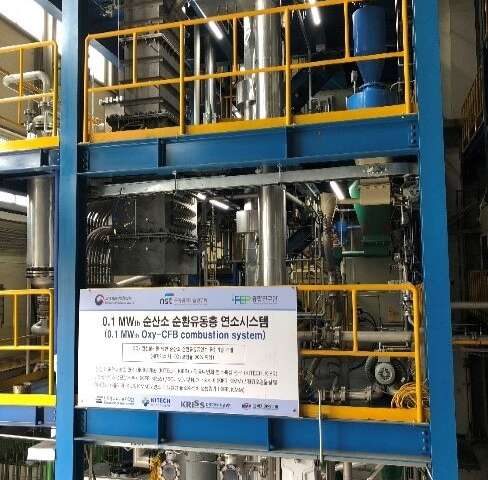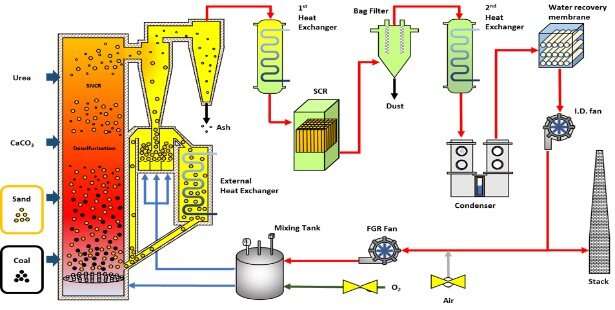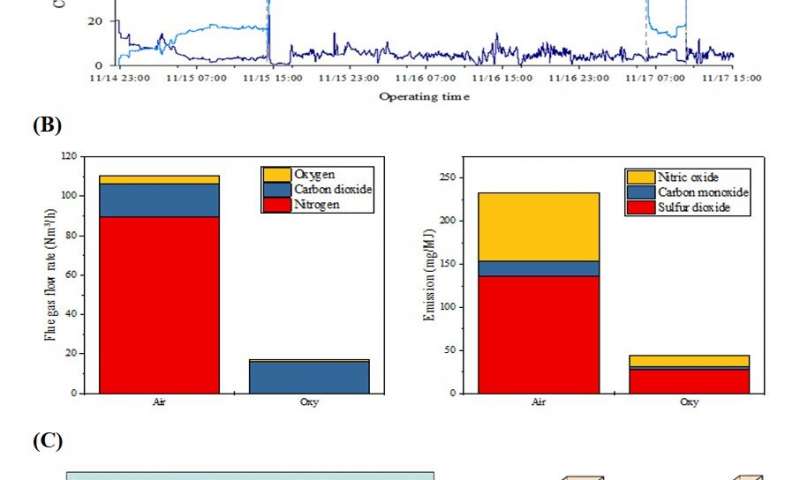
Coal-fired power plants in Korea are one of the main sources of air pollutants, CO2 and the other precursor materials to ultra-fine dust particulates such as nitrogen oxide and sulfur oxide. Therefore, FEPCRC is developing key technologies for eco-friendly coal-fired stackless power generation without emissions in flue gas.
The FEP Convergence Research Center (FEPCRC) led by Director Lee Jae-goo at the Korea Institute of Energy Research has successfully developed oxy-circulating fluidized bed combustion (Oxy-CFBC) technology that reduces air pollution by over 80% and separates over 90% of CO2 emissions compared to existing power plant technology with air mode combustion.
Oxy-CFBC is a promising and advanced combustion technology that makes it possible to separate CO2 efficiently, utilize low grade fuels and remove SOx and NOx by oxy-combustion process combined with CFBC technology.
This process operates below 950 degrees C and does not produce thermal NOx compared to other types of thermal power generation that require a high operating temperature. In addition, it removes NOx and SOx by injecting reducing agents such as urea/ammonia solutions and limestone particles inside combustor. As a result, the difficulty of installing a flue gas treatment system is reduced.
The Oxy-CFBC uses oxygen mixed with recirculating CO2 instead of air as an oxidant and requires only am air separation unit and a flue gas recirculation system, so it is easier to obtain highly concentrated CO2 compared to other carbon-capture technologies. Moreover, this process reduces air pollutants that generate ultra-fine dust as well as the amount of flue gas by about 80% compared to air mode combustion. The Oxy-CFBC process is one of the most advanced technologies that can be operated at 60% of O2 as an oxidant for oxy-combustion.

(1) 0.1 MWth Oxy-CFBC facility configuration: Feeding system of fuel and limestone for de-SOx, CFB combustor, Cyclone, loop seal, external heat exchanger, Heat exchangers, Flue gas recirculation unit, Bag filter for fine particle capture, Water recovery unit (FGC, Membrane), De-NOx unit (SNCR, SCR). (2) Competitive edge & differentiation: Development of design and operation technology for FEPCRC's own Oxy-CFBC plant ? Reduce the amount of flue gas by 80% compared to the air combustion, Combustion efficiency increases by 2% compared to the air combustion, Available to separate CO2 over 90% Credit: Korea Institute of Energy Research (KIER)
The higher oxygen concentration for Oxy-CFBC technology plays a critical role in improving the system's efficiency. Current technology uses oxygen concentrations at the level of 40%, but if oxygen concentration increases over 60%, the size of CFBC and downstream facilities can be reduced significantly, resulting in the reduction of capital cost and operating expenses.
The Oxy-CFBC test rig demonstrated that thermal input increases from 100 kWth to 200 kWth when oxygen concentration increases from 21% to 60%. This means that thermal power can be doubled in constant plant size or the plant size can be reduced for constant thermal power.

(A) Oxidant switching time(air?oxygen) : Less than 1 hour to obtain CO2 purity over 90 vol.% in flue gas.(B-left) Amount of flue gas: decrease of 80% compared to air mode combustion.(B-right) Amount of air pollutants: decrease of 80% for SO2, 85% for NO, and 76% for CO compared to air combustion before flue gas treatment.(C) Secured Oxy-CFBC operation technology with high oxygen concentration over 60% for oxy-combustion: Increase in oxygen concentration decreases the amount of gas flow, and which greatly reduces the size of boiler and down stream facilities, contributing to the reduction of construction cost and operating expenses. Available to double the capacity in the same facility Credit: Korea Institute of Energy Research (KIER)
FEPCRC also developed stable oxidant-switching technology from air-mode combustion to oxy-mode combustion or vice versa, and could obtain a CO2 concentration over 90% within one hour after oxidant switching from air to oxy mode.
Dr. Mun of FEPCRC, who participated in this R&D, said, "It is urgent to develop breakthrough technologies for CO2 and fine dust reduction. Our research team will continue to develop basic design, engineering and operating techniques related to the Oxy-CFBC process with our own technologies, contributing to advanced power generation technology that can separate CO2 during combustion process."